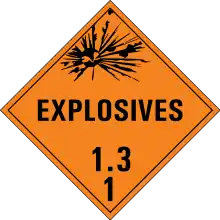A matrix of the United Nations explosives shipping classification system and examples of typical materials. Each classification consists of a Sub Class Number that indicates the type of hazard and a Compatibility group suffix describing which types of product may inhabit the same means of containment.[1]
Classes
Compatibility Group →Explosive Hazard↓ |
APrimary explosive substance |
BArticle, primary explosive, without two protective features |
CPropellant |
DArticle, Secondary Explosive or primary explosive with two protective features |
EArticle with Secondary Explosive, not self initiating, with propelling charge |
FArticle with Secondary Explosive, self initiating |
GPyrotechnics |
HExplosive Containing White Phosphorus |
JExplosive Containing a flammable liquid or gel |
KExplosive Containing a toxic substance |
LPresenting a special risk requiring isolation |
NExtremely Insensitive |
SPacked so hazard effects confined or so as not to hinder firefighting |
|---|---|---|---|---|---|---|---|---|---|---|---|---|---|
1.1Mass explosion Possible |
1.1A
Mercury fulminate, Lead azide Etc. |
1.1B
Blasting caps, ingitors |
1.1C | 1.1D
Detonating cord, explosive boosters, blackpowder, most secondary explosives |
1.1E | 1.1F | 1.1G
Flash powder, Bulk Salutes, very large fireworks |
1.1J
Liquid fuelled cruise missiles and torpedoes, incendiary bombs |
1.1L | ||||
1.2Projection but not mass explosion |
1.2B
Detonating fuzes |
1.2C
Rocket motors, propelling charges |
1.2D
Hand grenades, shaped charges |
1.2E
Rockets with bursting charges |
1.2F | 1.2G
Large fireworks, practice grenades |
1.2H
White phosphorus grenades |
1.2J | 1.2K
Chemical shells |
1.2L
Hypergolic fuelled rocket motors |
|||
1.3Fire, minor blast |
1.3C
Smokeless powder, rocket motors |
1.3F
Fuzed hand grenades |
1.3G
Display Fireworks, smoke grenades, flares |
1.3H | 1.3J | 1.3K | 1.3L
Hypergolic fuelled rocket motors |
||||||
1.4Minor explosion hazard. |
1.4B
Blasting Caps |
1.4C
Model rocket motors |
1.4D
Det. Cord |
1.4E | 1.4F | 1.4G
Consumer Fireworks, Proximate Pyro |
1.4S
Proximate Pyro, Blasting Caps, Small Arms Ammunition | ||||||
1.5Very insensitive, mass explosion hazard |
1.5D
Blasting Agents |
||||||||||||
1.6Extremely insensitive, no mass explosion hazard |
1.6N |
| Hazard
Division |
Compatibility Group | ||||||||||||
|---|---|---|---|---|---|---|---|---|---|---|---|---|---|
| A | B | C | D | E | F | G | H | J | K | L | N | S | |
| 1.1 | 1.1A | 1.1B | 1.1C | 1.1D | 1.1E | 1.1F | 1.1G | 1.1J | 1.1L | ||||
| 1.2 | 1.2B | 1.2C | 1.2D | 1.2E | 1.2F | 1.2G | 1.2H | 1.2J | 1.2K | 1.2L | |||
| 1.3 | 1.3C | 1.3F | 1.3G | 1.3H | 1.3J | 1.3K | 1.3L | ||||||
| 1.4 | 1.4B | 1.4C | 1.4D | 1.4E | 1.4F | 1.4G | 1.4S | ||||||
| 1.5 | 1.5D | ||||||||||||
| 1.6 | 1.6N | ||||||||||||
Compatibility Groups

In some cases it may be appropriate and safe to mix explosives when transporting or storing them, certain compatibility groups may be mixed with others and still remain safe.
| Compatibility
Group |
A | B | C | D | E | F | G | H | J | K | L | N | S |
|---|---|---|---|---|---|---|---|---|---|---|---|---|---|
| A | a. | ||||||||||||
| B | X | Xg. | |||||||||||
| C | X | Xc,d, | Xc. | Xf. | Xd. | Xg. | |||||||
| D | Xc,d, | X | Xc. | Xf. | Xd. | Xg. | |||||||
| E | Xc. | Xc. | X | Xf. | Xd. | Xg. | |||||||
| F | X | Xg. | |||||||||||
| G | Xf. | Xf. | Xf. | X | Xg. | ||||||||
| H | X | Xg. | |||||||||||
| J | X | Xg. | |||||||||||
| K | X | Xg. | |||||||||||
| L | Xb. | ||||||||||||
| N | Xd. | Xd. | Xd. | X | Xg. | ||||||||
| S | Xg. | Xg. | Xg. | Xg. | Xg. | Xg. | Xg. | Xg. | Xg. | Xg. | X |
X Denotes compatibility groups that can be mixed in transport.
Detonators/blasting caps, may not be packaged together with any other explosive.
a. Different explosives of compatibility group A should be packaged separately
b. Explosives of compatibility group L shall only be packed with an identical explosive.
c. Explosive articles of the compatibility group C, D, or E may be packed together, and the whole packaged shall be treated as belonging to compatibility group E.
d. Explosive articles of the compatibility group C and D may be packed together, and the whole packaged shall be treated as belonging to compatibility group D.
e. Explosive articles of the compatibility group C, D, E or N may be packed together, and the whole packaged shall be treated as belonging to compatibility group D.
f. Explosive belonging to the compatibility group G except for fireworks, may be packaged together with compatibility groups C, D, and E, provided they are not carried in the same compartment, carry box, or vehicle, and the whole packaged shall be treated as belonging to compatibility group E.
g. Explosive of compatibility group S, may be packaged together with explosives of any other group, except A or L, and the combined packaged may be treated as belonging to any of the compatibility groups most appropriate, except S.
See also
References
- ↑ INTERNATIONAL AMMUNITION TECHNICAL GUIDELINE (IATG) 01.50, UN explosive hazard classification system and codes, Second edition, 2015-02-01
- 1 2 "Federal Register :: Request Access". unblock.federalregister.gov. Retrieved 2023-10-05.
- ↑ "Definitions, Classification and Packaging for Class 1". www.govinfo.gov. Retrieved 2023-10-05.
Links
- INTERNATIONAL AMMUNITION TECHNICAL GUIDELINE (IATG) 01.50, UN explosive hazard classification system and codes, Second edition, 2015-02-01
- Transport Canada, Transportation of Dangerous Goods Regulations
- Transport Canada, Statutory Instruments (Regulations) SOR/2008-34
- Australian Code for the Transport of Explosives by Road or Rail - Third Edition